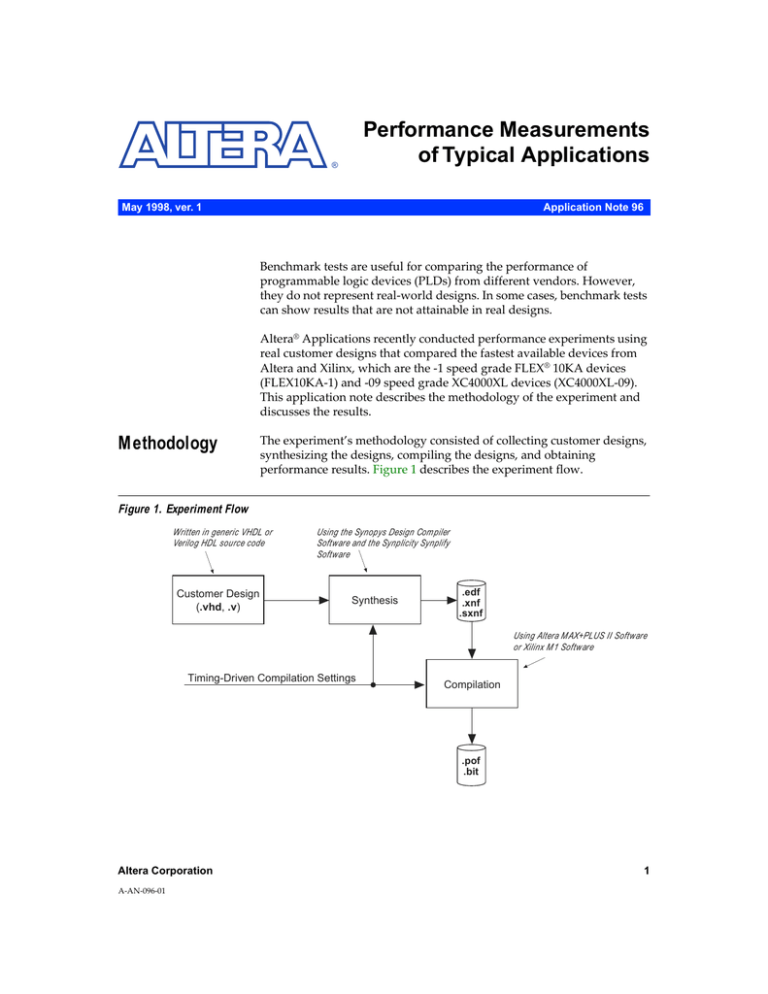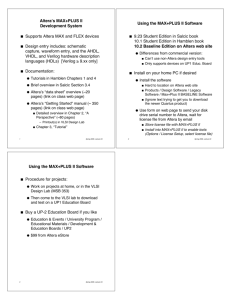
Performance Measurements
of Typical Applications
®
May 1998, ver. 1
Application Note 96
Benchmark tests are useful for comparing the performance of
programmable logic devices (PLDs) from different vendors. However,
they do not represent real-world designs. In some cases, benchmark tests
can show results that are not attainable in real designs.
Altera® Applications recently conducted performance experiments using
real customer designs that compared the fastest available devices from
Altera and Xilinx, which are the -1 speed grade FLEX® 10KA devices
(FLEX10KA-1) and -09 speed grade XC4000XL devices (XC4000XL-09).
This application note describes the methodology of the experiment and
discusses the results.
Methodology
The experiment’s methodology consisted of collecting customer designs,
synthesizing the designs, compiling the designs, and obtaining
performance results. Figure 1 describes the experiment flow.
Figure 1. Experiment Flow
Written in generic VHDL or
Verilog HDL source code
Customer Design
(.vhd, .v)
Using the Synopys Design Compiler
Software and the Synplicity Synplify
Software
Synthesis
.edf
.xnf
.sxnf
Using Altera MAX+PLUS II Software
or Xilinx M1 Software
Timing-Driven Compilation Settings
Compilation
.pof
.bit
Altera Corporation
A-AN-096-01
1
AN 96: Performance Measurements of Typical Applications
In the experiment, timing-driven compilation was turned on in the
synthesis and compilation tools, and for a given compilation, both tools
were set to the same timing-driven compilation settings. When timingdriven compilation is enabled, the synthesis or compilation tool focuses
on achieving a specified performance parameter for an overall design—
sometimes at the expense of logic element (LE) utilization. The use of
timing-driven compilation is discussed further in the synthesis and
compilation sections.
Determining Customer Designs
Altera collected about 50 actual customer designs for the experiment, but
only 13 designs were selected because they compiled successfully for both
FLEX 10KA-1 and XC4000XL-09 device families. To remove possible
biases from the experiment, each designs required the following
characteristics:
■
■
■
Designs were written in generic VHDL or Verilog HDL source code,
ensuring that they were unbiased toward either the Altera or Xilinx
architecture.
If a design used memory, the memory was mapped to logic, not to
silicon-specific memory structures (e.g., embedded array blocks).
None of the designs used floorplanning, instantiation, generic
function blocks, MegaCore™ functions, or pipelining.
Table 1 describes the 13 designs used in the experiment.
Table 1. Customer Designs Used in the Experiment
Name
LEs
I/O Pins
Design Entry Language
cpe_cable_modem
1,300
97
dma_controller
3,200
183
Verilog HDL
prbs_datatransmitter
1,400
150
VHDL
600
104
VHDL
3,600
223
VHDL
ram_controller
video_encoder
VHDL
video_convolver
1,400
219
VHDL
campus_switch
3,000
125
Verilog HDL
atm_switch
2,000
60
Verilog HDL
television_audio_receiver
3,700
233
VHDL
pci_core
2,500
275
VHDL
mips_r4000_processor
850
132
Verilog HDL
serial_parallel_shift_reg
600
36
2,500
189
print_controller
2
VHDL
Verilog HDL
Altera Corporation
AN 96: Performance Measurements of Typical Applications
The 13 customer designs were generally large, averaging over 2,000 LEs.
See Figure 2.
Figure 2. Customer Design LE Counts
Note (1)
ram_controller
serial_parallel_shift_reg
mips_r4000_processor
cpe_cable_modem
prbs_datatransmitter
video_convolver
Design Name
atm_switch
pci_core
print_controller
campus_switch
dma_controller
video_encoder
television_audio_receiver
0
500
1,000
1,500
2,000
2,500
3,000
3,500
4,000
LE Count
Note:
(1)
LE counts were determined during synthesis without timing-driven compilation.
Altera Corporation
3
AN 96: Performance Measurements of Typical Applications
Synthesizing the Designs
The 13 customer designs were synthesized using the Synopsys Design
Compiler software version 1997.01 and the Synplicity Synplify software
version 3.0B. Each design was synthesized 5 times with each synthesis
tool at various timing-driven compilation settings. Table 2 shows the
timing-driven compilation settings used in the experiment.
Table 2. Timing-Driven Compilation Settings Used
Synthesis Run #
Timing-Driven Compilation Setting (MHz)
1
10
2
20
3
30
4
40
5
50
Each synthesis tool generated a Xilinx netlist file (.xnf or .sxnf) for
XC4000XL-09 devices and an EDIF netlist file (.edf) for FLEX 10KA-1
devices. After synthesis was completed, the highest timing-driven
compilation performance rate was used for each design, regardless of
which synthesis tool produced it.
Compiling the Designs
The resulting netlist files (.edf, .xnf, or .sxnf) were compiled in Altera’s
MAX+PLUS II version 8.2 software or Xilinx’s M1 version 1.3.7 software,
respectively. The same timing-driven compilation settings used in
synthesizing the designs were used when compiling the designs. For
example, if a design was synthesized in the Synopsys Design Compiler
with timing-driven compilation set at 20 MHz, the design was compiled
in the MAX+PLUS II or M1 software with the same setting.
Obtaining Performance Results
After compilation, performance rates for the designs were measured
using timing analysis in the MAX+PLUS II or M1 software. Each design’s
best performance rate was used in the comparison.
4
Altera Corporation
AN 96: Performance Measurements of Typical Applications
Results
Figure 3 shows the results of the performance experiment.
Figure 3. Performance Comparison of FLEX 10KA-1 vs. XC4000XL-09 Devices
prbs_datatransmitter
ram_controller
video_convolver
campus_switch
pci_core
serial_parallel_shift_reg
Design Name
video_encoder
cpe_cable_modem
atm_switch
print_controller
FLEX 10KA-1 Devices
XC4000XL-09 Devices
dma_controller
mips_r4000_processor
television_audio_receiver
0
10
20
30
40
50
60
70
80
Performance (MHz)
Altera Corporation
5
AN 96: Performance Measurements of Typical Applications
Figure 4 shows the same results normalized for the Xilinx performance
results.
Figure 4. Normalized Performance
campus_swtich
pci_core
prbs_controller
video_encoder
cpe_cable_modem
Design
Name
ram_controller
mips_r4000 processor
video_convolver
television_audio_receiver
atm_switch
FLEX 10KA-1 Devices
XC4000XL-09 Devices
print_controller
serial_parallel_shift_reg
dma_controller
0
.20
.40
.60
.80
1.00
1.20
1.40
1.60
1.80
2.00
Performance Normalized to XC4000XL-09
6
Altera Corporation
AN 96: Performance Measurements of Typical Applications
Conclusion
This experiment showed that FLEX 10KA-1 devices outperform
XC4000XL-09 devices in every design. For these designs, FLEX 10KA-1
devices outperformed XC4000XL-09 devices by a median of 25% and an
average of 17%.
Because the designs used in the experiment were not optimized for the
target device architecture, they provide a worst-case analysis. Even so, the
results show that on average the FLEX 10K-1 devices operate at 40 MHz
without special design techniques. In most cases, designers will use
techniques to increase performance, such as:
■
■
■
■
Intellectual property—Using megafunctions that are pre-optimized for
a particular architecture.
Instantiation—Placing functions in close proximity to reduce the
overall timing.
Pipelining—Breaking up logic with registers to increase system
performance (this technique may require a bandwidth tradeoff).
Floorplanning—Manual intervention on speed-critical paths to
increase performance.
Using advanced design techniques can boost performance of the designs
used in this experiment up to an average of 70 MHz (an increase of 75%).
For more information on experiment results in which designs were
optimized for performance, refer to Application Note 98 (Comparing
Performance Using Common Megafunctions).
Additional
Information
The following documents provide more detailed information about
FLEX 10KA-1 devices:
■
■
FLEX 10K Embedded Programmable Logic Family Data Sheet
Application Note 97 (Comparing Performance of High-Density PLDs)
The documents are available by contacting Altera Literature Services at
(888) 3-ALTERA; you can also download them from the Altera web site at
http://www.altera.com.
Altera Corporation
7
AN 96: Performance Measurements of Typical Applications
®
101 Innovation Drive
San Jose, CA 95134
(408) 544-7000
http://www.altera.com
Applications Hotline:
(800) 800-EPLD
Customer Marketing:
(408) 544-7104
Literature Services:
(888) 3-ALTERA
lit_req@altera.com
8
Altera, FLEX, FLEX 10K, FLEX 10KA, MAX, MAX+PLUS, MAX+PLUS II, and MegaCore are trademarks
and/or service marks of Altera Corporation in the United States and other countries. Altera acknowledges the
trademarks of other organizations for their respective products or services mentioned in this document. Altera
products are protected under numerous U.S. and foreign patents and pending applications, maskwork rights,
and copyrights. Altera warrants performance of its semiconductor products to current specifications in
accordance with Altera’s standard warranty, but reserves the right to make changes to any products and
services at any time without notice. Altera assumes no responsibility or liability arising out
of the application or use of any information, product, or service described herein except as
expressly agreed to in writing by Altera Corporation. Altera customers are advised to obtain
the latest version of device specifications before relying on any published information and
before placing orders for products or services.
Copyright 1998 Altera Corporation. All rights reserved.
Altera Corporation
Printed on Recycled Paper.







